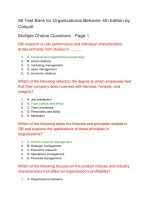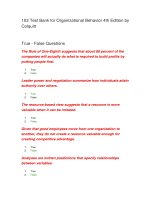Organizational behavior 4th by MShean chap004
Bạn đang xem bản rút gọn của tài liệu. Xem và tải ngay bản đầy đủ của tài liệu tại đây (402.19 KB, 28 trang )
4
Workplace Emotions
and Attitudes
McGraw-Hill/Irwin
© 2008 The McGraw-Hill Companies, Inc. All rights reserved.
Emotions and Attitudes at Wegmans
Courtesy of Wegmans Food Markets
Wegmans Food Market enjoys strong customer
loyalty and low employee turnover by keeping
employees happy. Shown here, CEO Danny Wegman
meets with staff during a new store opening.
McShane/Von Glinow OB4e
Slide 4-2
© 2008 The McGraw-Hill Companies, Inc. All rights reserved.
Emotions Defined
Courtesy of Wegmans Food Markets
Psychological, behavioral, and physiological
episodes experienced toward an object, person, or
event that create a state of readiness.
McShane/Von Glinow OB4e
Slide 4-3
© 2008 The McGraw-Hill Companies, Inc. All rights reserved.
Types of Emotions
Astonished
High
Fearful
Elated
Activation
High activation
Negative emotions
High activation
Positive emotions
Sad
Cheerful
Low activation
Negative emotions
Low activation
Positive emotions
Bored
Content
Tranquil
Low
Negative
McShane/Von Glinow OB4e
Evaluation
Slide 4-4
Positive
© 2008 The McGraw-Hill Companies, Inc. All rights reserved.
Attitudes versus Emotions
Attitudes
Emotions
Judgments about an attitude
object
Experiences toward an attitude
object
Based mainly on rational logic
Based on awareness of our
senses
Usually stable for days or
longer
Occur briefly, usually lasting
minutes
McShane/Von Glinow OB4e
Slide 4-5
© 2008 The McGraw-Hill Companies, Inc. All rights reserved.
Emotions, Attitudes and Behavior
Perceived Environment
Cognitive
process
Emotional
process
Beliefs
Attitude
Emotional
Episodes
Feelings
Behavioral
Intentions
Behavior
McShane/Von Glinow OB4e
Slide 4-6
© 2008 The McGraw-Hill Companies, Inc. All rights reserved.
Serious Fun at CXtex
• Cxtec employees live up
to their company
values, which include
having fun at work.
Courtesy of CXtec
McShane/Von Glinow OB4e
Slide 4-7
– Helium-filled balloons adorn
the office.
– Break room with billiards,
foosball, and air hockey.
– Miniature golf tournaments
in the office, tricycle races
around the building, and
“CXtec Idol” competitions.
© 2008 The McGraw-Hill Companies, Inc. All rights reserved.
Generating Positive Emotions at Work
• The emotions-attitudesbehavior model illustrates
that attitudes are shaped
by ongoing emotional
experiences.
Courtesy of CXtec
McShane/Von Glinow OB4e
Slide 4-8
• Thus, successful
companies actively create
more positive than
negative emotional
episodes.
© 2008 The McGraw-Hill Companies, Inc. All rights reserved.
Cognitive Dissonance
• A state of anxiety that occurs when an individual’s
beliefs, feelings and behaviors are inconsistent with
one another
• Most common when behavior is:
– known to others
– done voluntarily
– can’t be undone
McShane/Von Glinow OB4e
Slide 4-9
© 2008 The McGraw-Hill Companies, Inc. All rights reserved.
Emotional Labor
• The effort, planning and control needed to express
organizationally desired emotions during
interpersonal transactions.
• Emotional labor higher when job requires:
– frequent and long duration display of emotions
– displaying a variety of emotions
– displaying more intense emotions
McShane/Von Glinow OB4e
Slide 4-10
© 2008 The McGraw-Hill Companies, Inc. All rights reserved.
Emotional Labor Across Cultures
• Some cultures expect people to display a neutral
emotional demeanor, with minimal emotional
expression and monotonic voice (e.g. Korea, Japan,
Austria)
• Other cultures allow or encourage emotional
expression, where emotions are revealed through
voice and gestures (e.g. Kuwait, Egypt, Spain,
Russia)
McShane/Von Glinow OB4e
Slide 4-11
© 2008 The McGraw-Hill Companies, Inc. All rights reserved.
Emotional Labor Challenges
• Difficult to display expected emotions accurately,
and to hide true emotions
• Emotional dissonance
– Conflict between true and required emotions
– Potentially stressful with surface acting
– Less stress through deep acting
McShane/Von Glinow OB4e
Slide 4-12
© 2008 The McGraw-Hill Companies, Inc. All rights reserved.
Emotional Dissonance
• ED is the difference between required and true
emotions.
• One way to minimize ED is look for people who can
display required emotions.
• Employees should work on developing deep acting
rather than surface acting.
McShane/Von Glinow OB4e
Slide 4-13
© 2008 The McGraw-Hill Companies, Inc. All rights reserved.
Emotional Intelligence Defined
• Ability to perceive and express emotion,
assimilate emotion in thought, understand and
reason with emotion, and regulate emotion in
oneself and others
• It’s the ability to identify, assess, and manage
emotions of oneself, others, and of groups.
• EI represents a set of competencies that allow
us to perceive, understand, and regulate
emotions.
McShane/Von Glinow OB4e
Slide 4-14
© 2008 The McGraw-Hill Companies, Inc. All rights reserved.
Model of Emotional Intelligence
Highest
Relationship
Management
Managing other people’s emotions
Understanding and sensitivity to the
Social Awareness feelings, thoughts, and situation of
others
Controlling or redirecting our internal
Self-management states, impulses, and resources
Lowest
McShane/Von Glinow OB4e
Self-awareness
Understanding your own emotions,
strengths, weaknesses, values, and
motives
Slide 4-15
© 2008 The McGraw-Hill Companies, Inc. All rights reserved.
Emotional Intelligence Competencies
Self
(personal competence)
Other
(social competence)
Recognition
of emotions
Self-awareness
Social awareness
Regulation
of emotions
Self-management
Relationship
management
McShane/Von Glinow OB4e
Slide 4-16
© 2008 The McGraw-Hill Companies, Inc. All rights reserved.
Improving Emotional Intelligence
• Emotional intelligence is a set of competencies
(aptitudes, skills)
• Can be learned, especially through coaching
• EI increases with age -- maturity
McShane/Von Glinow OB4e
Slide 4-17
© 2008 The McGraw-Hill Companies, Inc. All rights reserved.
Job Satisfaction
• A person's evaluation of
his or her job and work
context
• A collection of attitudes
about specific facets of
the job
Job
Satisfaction
Career
Progress
Pay and
Benefits
McShane/Von Glinow OB4e
Job
Content
Slide 4-18
Supervisor
Co-workers
Working
Conditions
© 2008 The McGraw-Hill Companies, Inc. All rights reserved.
EVLN: Responses to Dissatisfaction
Exit
Voice
McShane/Von Glinow OB4e
• Leaving the situation
• Quitting, transferring
• Changing the situation
• Problem solving, complaining
Loyalty
• Patiently waiting for the situation
to improve
Neglect
• Reducing work effort/quality
• Increasing absenteeism
Slide 4-19
© 2008 The McGraw-Hill Companies, Inc. All rights reserved.
Job Satisfaction and Performance
• Happy workers are somewhat more productive
workers, but:
1. General attitude is a poor predictor of specific
behaviors
2. Job performance affects satisfaction only when
rewarded
3. Job satisfaction and motivation have little effect in
jobs with little employee control (e.g. assembly lines)
McShane/Von Glinow OB4e
Slide 4-20
© 2008 The McGraw-Hill Companies, Inc. All rights reserved.
Happy Staff, Happy Customers at Outback
Outback Steakhouse is
successful in part
because it applies the
principle that happy
employees make happy
customers, which result
in happy shareholders.
Courtesy of Outback Steakhouse
McShane/Von Glinow OB4e
Slide 4-21
© 2008 The McGraw-Hill Companies, Inc. All rights reserved.
Job Satisfaction and Customers
Job satisfaction
increases customer
satisfaction and
profitability because:
– Job satisfaction affects mood,
leading to positive behaviors
toward customers
– Less employee turnover,
resulting in more consistent
and familiar service
McShane/Von Glinow OB4e
Slide 4-22
Courtesy of Outback Steakhouse
© 2008 The McGraw-Hill Companies, Inc. All rights reserved.
Organizational Commitment
• Organizational commitment
– Emotional attachment to, identification with, and
involvement in an organization. aka Affective
Commitment is a competitive advantage, improves
customer satisfaction, motivates employees and reduces
turnover
• Continuance commitment
– Belief that staying with the organization serves your
personal interests and quitting would be costly
financial incentives or penalties force employees to stay
with the organization and reduces turnover
McShane/Von Glinow OB4e
Slide 4-23
© 2008 The McGraw-Hill Companies, Inc. All rights reserved.
Building Organizational Commitment
Justice & support
Shared values
Trust
• Apply humanitarian values
• Support employee wellbeing
• Values congruence
• Employees trust org leaders
• Job security supports trust
Organizational
comprehension
• Know firm’s past/present/future
• Open and rapid communication
Employee
involvement
• Employees feel part of company
• Involvement demonstrates trust
McShane/Von Glinow OB4e
Slide 4-24
© 2008 The McGraw-Hill Companies, Inc. All rights reserved.
Psychological Contract Defined
Beliefs about the terms and conditions of a reciprocal
exchange between that person and other is
psychological contract.
Transactional contracts are short-term economic
exchanges, responsibilities are well defined around
narrow set of obligations
Relational contracts are long-term attachments that
encompass a broad array of subjective mutual
obligations.
McShane/Von Glinow OB4e
Slide 4-25
© 2008 The McGraw-Hill Companies, Inc. All rights reserved.









